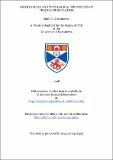Files in this item
Geometrical and topological properties of fractal percolation
Item metadata
| dc.contributor.advisor | Falconer, K. J. | |
| dc.contributor.author | Orzechowski, Mark E. | |
| dc.coverage.spatial | 130 p. | en_US |
| dc.date.accessioned | 2018-06-11T13:58:57Z | |
| dc.date.available | 2018-06-11T13:58:57Z | |
| dc.date.issued | 1998 | |
| dc.identifier.uri | https://hdl.handle.net/10023/13907 | |
| dc.description.abstract | The basic 'fractal percolation' process was first proposed by Mandelbrot in 1974 and takes the following form. Let M ≥2 and P ∈ [0,1]; we start with the unit square C₀ = [0,1]²; Divide C₀ into M² equal closed squares, each of side-length M⁻¹ , in the natural way and retain each of these squares with probability p, or else remove it with probability 1 - p. We let C₁ be the union of those squares retained. The process is now repeated within each square of C₁ to give a new set C₂⊆C₁, consisting of squares of side-length M⁻². Iterating the construction in the obvious way, we obtain a decreasing sequence of sets C₀⊇ C₁ ⊇ C₂ ⊇ … with limit C[sub]∞ = ∩[sub]n≥₁C[sub]n. The set C[sub]∞ is an example of a random Cantor set, and is typically highly intricate in nature. It may be empty, dust-like or highly connected, depending on the value of p; percolation is said to occur if C[sub]∞ contains large connected components linking opposite sides of the unit square. In this thesis we shall investigate some of the geometrical and topological properties of C[sub]∞ that hold either almost surely (with probability 1) or with non-zero probability. In particular, the following results are established. We obtain (almost sure) lower and upper bounds on the box-counting dimension of the 'straightest' crossings in C[sub]∞ whenever percolation occurs; we also look at the distribution of the sizes of the connected components and the probability of percolation. In the three-dimensional version of the process, we establish the existence of two distinct phases of percolation, corresponding to the occurrence of paths and surfaces (or 'sheets') in the limit set, and study the limiting behaviour of the phase transition to sheet percolation as M → ∞. We also consider the results of some computer simulations of fractal percolation and present a number of generalisations of the basic process and other closely related constructions. | en_US |
| dc.language.iso | en | en_US |
| dc.publisher | University of St Andrews | en |
| dc.subject.lcc | QA614.86O8 | |
| dc.subject.lcsh | Fractals | en |
| dc.title | Geometrical and topological properties of fractal percolation | en_US |
| dc.type | Thesis | en_US |
| dc.contributor.sponsor | Engineering and Physical Sciences Research Council (EPSRC) | en_US |
| dc.type.qualificationlevel | Doctoral | en_US |
| dc.type.qualificationname | PhD Doctor of Philosophy | en_US |
| dc.publisher.institution | The University of St Andrews | en_US |
This item appears in the following Collection(s)
Items in the St Andrews Research Repository are protected by copyright, with all rights reserved, unless otherwise indicated.

